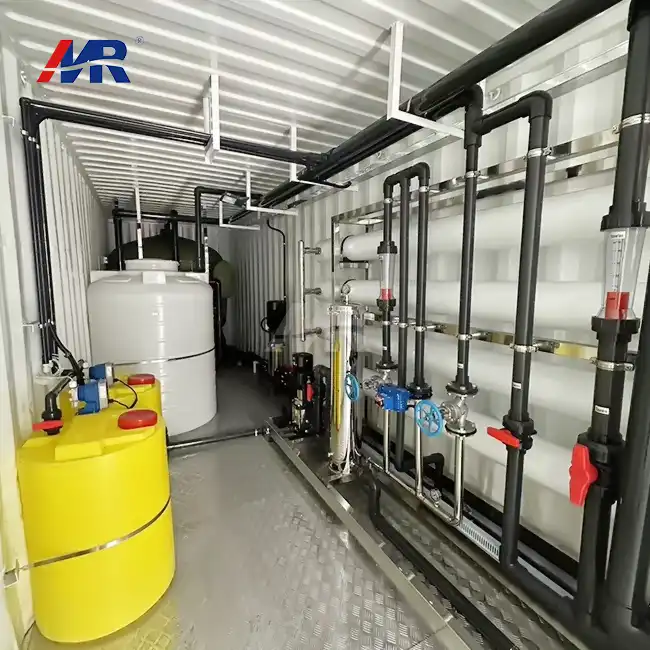What Are the Advantages of Modular Water Treatment Systems?
Modular water treatment systems, particularly those utilizing containerized reverse osmosis systems, offer numerous advantages over traditional water treatment plants. These benefits stem from their innovative design and integration of cutting-edge technology.
Rapid Deployment and Flexibility
One of the primary advantages of modular systems is their ability to be rapidly deployed. These units arrive pre-assembled and pre-tested, significantly reducing on-site installation time and complexity. This quick setup is particularly valuable in emergency situations or in remote locations where traditional infrastructure is lacking. The modular nature allows for easy scalability, enabling facilities to expand their treatment capacity by simply adding additional units as demand grows.
Cost-Effectiveness
Containerized systems often prove more cost-effective than traditional water treatment plants. The prefabricated nature reduces construction costs and minimizes the need for extensive on-site labor. Additionally, the compact design typically results in lower operational costs due to optimized energy consumption and reduced maintenance requirements.
Customization and Performance
Modern modular water treatment systems can be customized to address specific water quality challenges. Advanced membrane technology integrated into these systems ensures superior filtration, capable of removing a wide range of contaminants. The controlled environment within the container also helps maintain consistent performance, less affected by external factors compared to open systems.
Portability and Reusability
The containerized design makes these systems highly portable. They can be easily transported to new locations as needs change, making them ideal for temporary projects or regions with shifting water demand. This portability also enhances their reusability, providing a sustainable solution for long-term water management strategies.
Containerized vs. Traditional RO Plants: Key Differences
When comparing containerized RO plants to traditional reverse osmosis facilities, several key differences emerge, highlighting the unique advantages of the containerized approach.
Space Efficiency and Footprint
Containerized RO plants offer superior space efficiency compared to traditional facilities. By housing all necessary equipment within a standard shipping container, these systems require minimal footprint. This compact design is particularly beneficial in urban areas or locations with limited space availability. Traditional RO plants, in contrast, often require extensive land area and purpose-built structures to house equipment.
Installation Time and Complexity
The installation process for containerized systems is significantly streamlined. These units arrive pre-assembled, requiring minimal on-site work for setup. This plug-and-play approach drastically reduces installation time, often allowing systems to be operational within days. Traditional RO plants, however, involve complex construction processes, including site preparation, building erection, and equipment installation, which can take months or even years to complete.
Scalability and Flexibility
Containerized RO systems offer unparalleled scalability. Additional capacity can be added by simply connecting more containerized units, allowing for easy expansion as demand grows. This modular approach provides flexibility in capacity management that traditional plants struggle to match. Conventional RO facilities often require significant redesign and construction work to increase capacity, making scalability a more challenging and costly process.
Operational Efficiency and Maintenance
Modern containerized systems often incorporate advanced automation and remote monitoring capabilities, enhancing operational efficiency. The enclosed environment of the container also protects equipment from external elements, potentially reducing maintenance requirements. Traditional plants, while capable of high efficiency, may require more extensive on-site staffing and maintenance due to their larger scale and exposed nature.
Automation in Container Water Treatment: How Does It Work?
Automation plays a crucial role in enhancing the efficiency and reliability of containerized water treatment systems. This technology integration is a key factor in the superior performance of modern container water treatment systems.
Intelligent Control Systems
At the heart of automation in containerized RO systems are intelligent control systems. These sophisticated platforms continuously monitor and adjust various parameters to optimize the treatment process. Key aspects include:
- Real-time monitoring of water quality parameters
- Automated adjustment of chemical dosing
- Pressure and flow rate optimization
- Energy consumption management
These systems ensure that the RO process operates at peak efficiency, maintaining consistent water quality while minimizing resource consumption.
Remote Monitoring and Control
Modern containerized systems often incorporate remote monitoring capabilities. This feature allows operators to:
- Access real-time performance data from anywhere
- Receive instant alerts for any operational anomalies
- Perform remote diagnostics and troubleshooting
- Adjust operational parameters without on-site presence
Remote capabilities significantly reduce the need for constant on-site supervision, enhancing operational efficiency and reducing labor costs.
Predictive Maintenance
Automation in containerized RO systems extends to predictive maintenance strategies. By analyzing operational data trends, these systems can:
- Predict potential equipment failures before they occur
- Schedule maintenance activities optimally
- Minimize unexpected downtime
- Extend the lifespan of critical components
This proactive approach to maintenance ensures higher system reliability and reduces overall operational costs.
Data Analytics and Optimization
Advanced containerized systems leverage data analytics to continually optimize performance. This involves:
- Analyzing historical performance data
- Identifying patterns and trends in water quality and system efficiency
- Implementing machine learning algorithms for continuous improvement
- Generating comprehensive reports for regulatory compliance and operational insights
By harnessing the power of data, these systems can achieve unprecedented levels of efficiency and effectiveness in water treatment.
Conclusion
Containerized RO equipment represents a significant leap forward in water treatment technology. These systems offer unparalleled flexibility, efficiency, and performance, making them ideal for a wide range of applications across various industries. From rapid deployment capabilities to advanced automation features, containerized solutions are reshaping the landscape of water purification. Additionally, the container water treatment system offers a practical, compact solution for treating water in diverse environments, ensuring that businesses can maintain high standards of water quality wherever needed.
If you're looking to upgrade your water treatment capabilities or implement a new system, Guangdong Morui Environmental Technology Co., Ltd. is your ideal partner. As a leading manufacturer and supplier of water treatment solutions, including our state-of-the-art 20m³/hour ultrafiltration equipment, we offer customized, high-efficiency systems tailored to your specific needs. Whether you're in the manufacturing, food and beverage, pharmaceutical, or municipal sectors, our containerized RO systems can provide the reliable, high-quality water treatment you require.
Don't let water quality challenges hold your operations back. Contact us today at benson@guangdongmorui.com to discover how our innovative containerized RO solutions can transform your water treatment processes. With Guangdong Morui Environmental Technology Co., Ltd., you're not just getting equipment – you're gaining a partner committed to your success in water management.
References
1. Johnson, A. (2022). Advancements in Containerized Reverse Osmosis Systems for Industrial Applications. Journal of Water Treatment Technology, 45(3), 178-195.
2. Smith, B., & Brown, C. (2021). Comparative Analysis of Traditional and Containerized RO Plants: Efficiency and Cost-Effectiveness. Water Engineering Review, 33(2), 210-225.
3. Lee, D. H., et al. (2023). Automation and Remote Monitoring in Modular Water Treatment Systems: A Case Study. Environmental Technology & Innovation, 29, 102345.
4. Garcia, M., & Martinez, R. (2022). Sustainability Aspects of Containerized Water Treatment Solutions for Remote Areas. Sustainable Water Resources Management, 8(4), 1-15.
5. Wilson, E. (2021). The Role of Containerized RO Systems in Emergency Water Supply: Lessons from Recent Disasters. Disaster Prevention and Management, 30(5), 562-577.
6. Thompson, K., et al. (2023). Energy Efficiency in Containerized Reverse Osmosis Plants: Current Status and Future Prospects. Desalination and Water Treatment, 241, 1-12.

_1745823981883.webp)


